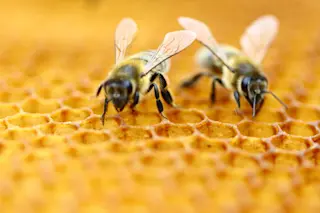Honey bees are a great study system to learn about the animal kingdom. They dance (albeit sloppily), they make jelly that turns their larvae into queens, they have crazy tongues … I could go on. Now, researchers have found, honeybees can add.
In a paper out today in Science Advances, a team led by Adrian Dyer at RMIT University in Melbourne put the honey-makers’ arithmetic skills to the test. Instead of written numbers and symbols, they used colors to communicate with the bees. Blue for addition, yellow for subtraction, and a series of shapes to denote the numbers.
They put each honeybee in a Y-shaped maze, where they’d be shown one to five shapes that were either blue or yellow. If the shapes were blue, they needed to fly toward the picture containing one additional shape. If the shapes were yellow, they needed to pick the choice with one fewer ...














